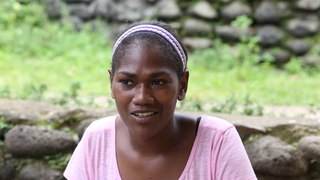Related Research Articles

The Philippine languages are a proposed group by R. David Paul Zorc (1986) and Robert Blust that include all the languages of the Philippines and northern Sulawesi—except Sama–Bajaw and a few languages of Palawan—and form a subfamily of Austronesian languages. Although the Philippines is near the center of Austronesian expansion from Formosa, there is little linguistic diversity among the approximately 150 Philippine languages, suggesting that earlier diversity has been erased by the spread of the ancestor of the modern Philippine languages.
The nine South Vanuatu languages form a family of the Southern Oceanic languages, spoken in Tafea Province of Vanuatu.

The twenty Micronesian languages form a family of Oceanic languages. Micronesian languages are known for their lack of plain labial consonants; they have instead two series, palatalized and labio-velarized labials.
The Mussau-Emira language is spoken on the islands of Mussau and Emirau in the St Matthias Islands in the Bismarck Archipelago.

The Southern Oceanic languages are a linkage of Oceanic languages spoken in Vanuatu and New Caledonia. It was proposed by Lynch, Ross, and Crowley in 2002 and supported by later studies. They consider it to be a linkage rather than a language group with a clearly defined internal nested structure.
The Republic of Vanuatu has the world's highest linguistic density per capita.
Nese is a moribund Oceanic language or dialect known by no more than twenty people in the Matanvat area of the northwest tip of the island of Malakula in Vanuatu. It is now rarely spoken, having been replaced as a primary mode of communication by Bislama.
Adzera is an Austronesian language spoken by about 30,000 people in Morobe Province, Papua New Guinea.
Anejom̃ or Aneityum is an Oceanic language spoken by 900 people on Aneityum Island, Vanuatu. It is the only indigenous language of Aneityum.
Proto-Oceanic is a proto-language that historical linguists since Otto Dempwolff have reconstructed as the hypothetical common ancestor of the Oceanic subgroup of the Austronesian language family. Proto-Oceanic is a descendant of the Proto-Austronesian language (PAN), the common ancestor of the Austronesian languages.
Wolio is an Austronesian language spoken in and around Baubau on Buton Island, Southeast Sulawesi, Indonesia. It belongs to the Wotu–Wolio branch of the Celebic subgroup. Also known as Buton, it is a trade language and the former court language of the Sultan at Baubau. Today it is an official regional language; street signs are written in the Buri Wolio alphabet, based on the Arabic script.

Karo, referred to in Indonesia as Bahasa Karo, is an Austronesian language that is spoken by the Karo people of Indonesia. It is used by around 600,000 people in North Sumatra. It is mainly spoken in Karo Regency, southern parts of Deli Serdang Regency and northern parts of Dairi Regency, North Sumatra, Indonesia. It was historically written using the Batak alphabet which is descended from the Brahmi script of ancient India by way of the Pallava and Old Kawi scripts, but nowadays only a tiny number of Karo can write or understand the script, and instead the Latin script is used.
Uma is an Austronesian language spoken in Central and South Sulawesi, Indonesia.
Puluwatese is a Micronesian language of the Federated States of Micronesia. It is spoken on Poluwat.

Vurës is an Oceanic language spoken in the southern area of Vanua Lava Island, in the Banks Islands of northern Vanuatu, by about 2000 speakers.
Tondano is an Austronesian language spoken in the Tondano area of northeast Sulawesi, Indonesia. It is most similar to Tombulu and to Tonsea.
Port Sandwich, or Lamap, is an Oceanic language spoken in southeast Malekula, Vanuatu, on the eastern tip of the island. It was first described in 1979 by French linguist Jean-Michel Charpentier.
Darrell T. Tryon was a New Zealand-born linguist, academic, and specialist in Austronesian languages. Specifically, Tryon specialised in the study of the languages of the Pacific Islands, particularly Vanuatu, the Solomon Islands, and the French-speaking Pacific.

Bantoanon or Asi is a regional Bisayan language spoken, along with Romblomanon and Onhan, in the province of Romblon, Philippines. Asi originated in the island of Banton, Romblon and spread to the neighboring islands of Sibale, Simara, and the towns of Odiongan and Calatrava on Tablas Island. The Asi spoken in Odiongan is called Odionganon, Calatravanhon in Calatrava, Sibalenhon in Concepcion, Simaranhon in Corcuera, and Bantoanon in Banton.
Rajbanshi is a Bengali-Assamese language spoken in Nepal. It is related to, but distinct from Rangpuri/Kamta in Bangladesh and India, which is also known by the alternative name "Rajbanshi", with which it forms the KRNB cluster.
References
- Lynch, John (1977). Lenakel Dictionary . Pacific Linguistics Series C - No. 55. Canberra: Pacific Linguistics. doi: 10.15144/pl-c55 . hdl: 1885/146596 . ISBN 0-85883-165-1.
- Lynch, John (1978). A Grammar of Lenakel . Pacific Linguistics Series B - No. 55. Canberra: Pacific Linguistics. doi: 10.15144/pl-b55 . hdl: 1885/146494 . ISBN 0-85883-166-X.
- Lynch, John; Crowley, Terry (2001). Languages of Vanuatu: a new survey and bibliography (PDF). Pacific linguistics 517. Canberra: Pacific Linguistics. doi: 10.15144/pl-517 . hdl: 1885/146135 . ISBN 0-85883-469-3.